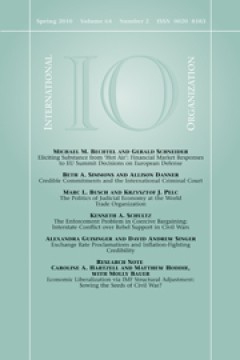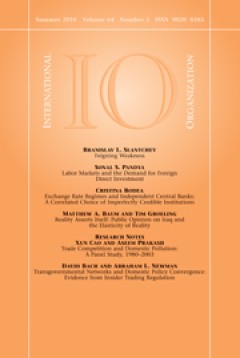Filter by

The Politics of Personality in Brazil
Dilma Rousseff won the 2010 presidential election as the handpicked successor of a towering political personality. Now she must assert firm sway over a ruling party and coalition to which she has remarkably slender ties, and face new challenges that her country cannot meet with ďmore of the same.Ē
- Edition
- Volume 22, Number 2, April 2011, pp. 75-88
- ISBN/ISSN
- 10497315
- Collation
- -
- Series Title
- Journal of Democracy
- Call Number
- -

Kenya’s New Constitution
Wracked by postelection violence in 2007 and 2008, Kenya embarked upon a course of constitutional change that culminated in an August 2010 referendum. How was the new basic law framed and passed, and what will it mean for democracy in this key East African country?
- Edition
- Volume 22, Number 2, April 2011,pp. 89-103
- ISBN/ISSN
- 10497315
- Collation
- -
- Series Title
- Journal of Democracy
- Call Number
- -

Latin America’s Gay-Rights Revolution
Even before Argentinaís landmark gay-marriage law was passed in July 2010, a gay-rights revolution was well underway across Latin America. But do gay rights by law equal acceptance of gays in practice?
- Edition
- Volume 22, Number 2, April 2011, pp. 104-118
- ISBN/ISSN
- 10497315
- Collation
- -
- Series Title
- Journal of Democracy
- Call Number
- -

Jordan Votes : Election or Selection?
In late 2010, not long before seismic political change was to erupt across the Middle East, Jordan held parliamentary elections. Officials were eager to present these as a fresh start, but a closer look tells a different tale.
- Edition
- Volume 22, Number 2, April 2011, 119-129
- ISBN/ISSN
- 10497315
- Collation
- -
- Series Title
- Journal of Democracy
- Call Number
- -

Sri Lanka : From Turmoil to Dynasty
Having only recently emerged from a prolonged and remarkably bitter civil war, Sri Lanka is now slipping steadily under the hardening authoritarian control of President Mahinda Rajapaksa and his family.
- Edition
- Volume 22, Number 2, April 2011, 130-144
- ISBN/ISSN
- 10497315
- Collation
- -
- Series Title
- Journal of Democracy
- Call Number
- -

Marital Name Change as a Window into Gender Attitudes
The need to revise scholarsí approach to the measurement of gender attitudesólong dominated by the separate-spheres paradigmóis growing increasingly timely as womenís share of the labor force approaches parity with menís. Recent years have seen revived interest in marital name change as a gendered practice with the potential to aid in this task; however, scholars have yet to test its effectiven‚Ķ
- Edition
- Vol. 25 no. 2, April 2011.pp. 145-175
- ISBN/ISSN
- 08912432
- Collation
- -
- Series Title
- Gender & Society
- Call Number
- -

Mothers, Fathers, and ‚ÄúMathers‚ÄĚ : Negotiating a Lesbian Co-parental Identity
This article argues that to gain a more complete understanding of how lesbian families experience parenthood outside of the heterosexual context, scholars must consider how co-parents negotiate a parental identity, rather than presuming that women parents want to mother. Drawing on in-depth interviews with 17 women in a state that denies them parental legal rights, this article asks how a nonób‚Ķ
- Edition
- Vol. 25 no. 2, April 2011.pp. 176-196
- ISBN/ISSN
- 08912432
- Collation
- -
- Series Title
- Gender & Society
- Call Number
- -

Gender in Twentieth-Century Children’s Books : Patterns of Disparity in Tit…
Gender representations reproduce and legitimate gender systems. To examine this aspect of the gendered social order, we analyze the representation of males and females in the titles and central characters of 5,618 childrenís books published throughout the twentieth century in the United States. Compared to females, males are represented nearly twice as often in titles and 1.6 times as often as ‚Ķ
- Edition
- Vol. 25 no. 2, April 2011 .pp. 197-226
- ISBN/ISSN
- 08912432
- Collation
- -
- Series Title
- Gender & Society
- Call Number
- -

Equity or Essentialism? : U.S. Courts and the Legitimation of Girls’ Teams …
Feminist scholars have critically analyzed the effects of sex segregation in numerous social institutions, yet sex-segregated sport often remains unchallenged. Even critics of sex-segregated sport have tended to accept the merits of women-only teams at face value. In this article, we revisit this issue by examining the underlying assumptions supporting womenís and girlsí teams and explore how t‚Ķ
- Edition
- Vol. 25 no. 2, April 2011.pp. 227-249
- ISBN/ISSN
- 08912432
- Collation
- -
- Series Title
- Gender & Society
- Call Number
- -

Updating the Outcome : Gay Athletes, Straight Teams, and Coming Out in Educat…
In this article I report findings from interviews with 26 openly gay male athletes who came out between 2008 and 2010. I compare their experiences to those of 26 gay male athletes who came out between 2000 and 2002. The athletes in the 2010 cohort have had better experiences after coming out than those in the earlier cohort, experiencing less heterosexism and maintaining better support among th…
- Edition
- Vol. 25 no. 2, April 2011.p. 250-268
- ISBN/ISSN
- 08912432
- Collation
- -
- Series Title
- Gender & Society
- Call Number
- -

Eliciting Substance from ‚ÄėHot Air‚Äô : Financial Market Responses to EU Sum‚Ķ
The results of deliberations in multilateral fora are often considered ineffective. Decision making in the European Union (EU) and in particular its key intergovernmental body, the European Council, poses no exception. Especially in the domain of EU foreign and security affairs, the unanimity requirement governing this institution allegedly allows nationalist governments to torpedo any attempt …
- Edition
- Vol 64, No. 2, April 2010,pp.199-223
- ISBN/ISSN
- 00208183
- Collation
- -
- Series Title
- International Organization
- Call Number
- -

Credible Commitments and the International Criminal Court
The creation of an International Criminal Court (ICC) to prosecute war crimes poses a real puzzle. Why was it created, and more importantly, why do states agree to join this institution? The ICC represents a serious intrusion into a traditional arena of state sovereignty: the right to administer justice to one's one nationals. Yet more than one hundred states have joined. Social scientists are …
- Edition
- Vol. 64, No. 2, April 2010.pp.225-256
- ISBN/ISSN
- 00208183
- Collation
- -
- Series Title
- International Organization
- Call Number
- -

The Politics of Judicial Economy at the World Trade Organization
International institutions often moderate the legal decisions they render. World Trade Organization (WTO) panels do this by exercising judicial economy. This practice, which is evident in 41 percent of all rulings, involves the decision not to rule on some of the litigants' arguments. The constraint is that it can be appealed. We argue that panels exercise judicial economy when the wider member…
- Edition
- Vol. 64, No. 2, April 2010.pp.257-279
- ISBN/ISSN
- 00208183
- Collation
- -
- Series Title
- International Organization
- Call Number
- -

The Enforcement Problem in Coercive Bargaining : Interstate Conflict over Reb…
This article explores the strategic problems that arise when a state seeks to use military force to compel changes in another state's policies. Although the costs associated with military action mean that there generally exist compromises that both sides prefer to conflict, bargaining may fail if such deals are not enforceable in the face of temptations to renege on policy concessions. This stu…
- Edition
- Vol. 64, No. 2< April 2010.pp.281-312
- ISBN/ISSN
- 00208183
- Collation
- -
- Series Title
- International Organization
- Call Number
- -

Exchange Rate Proclamations and Inflation-Fighting Credibility
If governments choose economic policies that often run counter to their public commitments, are those commitments meaningless? We argue that government proclamations can be critical in signaling economic policy intentions. We focus on the realm of exchange rate policy, in which countries frequently implement an exchange rate regime that differs from the officially declared regime. We argue that…
- Edition
- Vol. 64, No. 2, April 2010.pp.313-337
- ISBN/ISSN
- 00208183
- Collation
- -
- Series Title
- International Organization
- Call Number
- -

Economic Liberalization via IMF Structural Adjustment : Sowing the Seeds of C…
Previous studies that have explored the effects of economic liberalization on civil war have employed aggregate measures of openness and have failed to account for potential endogeneity bias. In this research note, we suggest two improvements to the study of the relationship between liberalization and civil war. First, emphasizing that it is processes that systematically create new economic win…
- Edition
- Vol. 64, No. 2, April 2010.pp.339-356
- ISBN/ISSN
- 00208183
- Collation
- -
- Series Title
- International Organization
- Call Number
- -

Feigning Weakness
In typical crisis bargaining models, strong actors must convince the opponent that they are not bluffing and the only way to do so is through costly signaling. However, in a war, strong actors can benefit from tactical surprise when their opponent mistakenly believes that they are weak. This creates contradictory incentives during the pre-war crisis: actors want to persuade the opponent of thei…
- Edition
- Vol. 64, No. 3, July 2010.pp. 357-388
- ISBN/ISSN
- 00208183
- Collation
- -
- Series Title
- International Organization
- Call Number
- -

Labor Markets and the Demand for Foreign Direct Investment
Existing research on foreign direct investment (FDI) focuses on how politics influences the supply of FDI inflows. In this article I shift focus to the demand for FDI inflows within recipient countries by examining individual preferences for FDI. I argue that FDI preferences are largely a function of FDI's effects on income. FDI raises wages, especially those of skilled labor because foreign fi…
- Edition
- Vol.64, No.3,July 2010.pp.389-409
- ISBN/ISSN
- 00208183
- Collation
- -
- Series Title
- International Organization
- Call Number
- -

Exchange Rate Regimes and Independent Central Banks : A Correlated Choice of …
Theory and empirical evidence show that low inflation is a precondition for economic growth. Independent central banks and fixed exchange rates are institutional mechanisms that help keep inflation low by lending monetary policy credibility to governments. However, the two institutions are commonly analyzed as substitutes that tie the hands of inflation prone governments. Thus, the literature h…
- Edition
- Vol. 64,No. 3, July 2010.pp.411-442
- ISBN/ISSN
- 00208183
- Collation
- -
- Series Title
- International Organization
- Call Number
- -

Reality Asserts Itself : Public Opinion on Iraq and the Elasticity of Reality
Prevailing theories hold that U.S. public support for a war depends primarily on its degree of success, U.S. casualties, or conflict goals. Yet, research into the framing of foreign policy shows that public perceptions concerning each of these factors are often endogenous and malleable by elites. In this article, we argue that both elite rhetoric and the situation on the ground in the conflict …
- Edition
- Vol. 64, No. 3, July 2010.pp. 443-479
- ISBN/ISSN
- 00208183
- Collation
- -
- Series Title
- International Organization
- Call Number
- -
 Computer Science, Information & General Works
Computer Science, Information & General Works  Philosophy & Psychology
Philosophy & Psychology  Religion
Religion  Social Sciences
Social Sciences  Language
Language  Pure Science
Pure Science  Applied Sciences
Applied Sciences  Art & Recreation
Art & Recreation  Literature
Literature  History & Geography
History & Geography